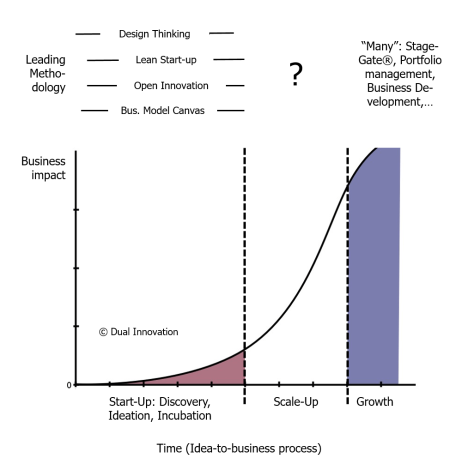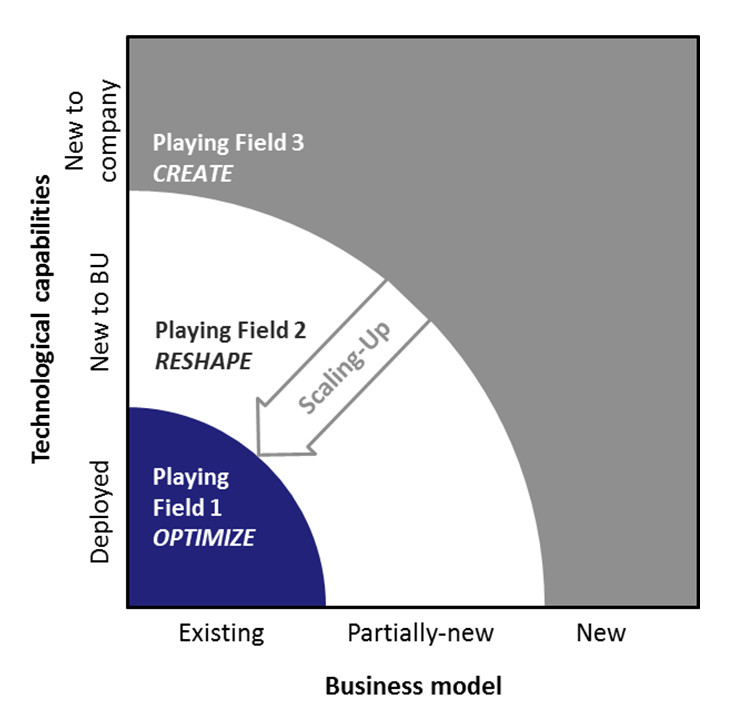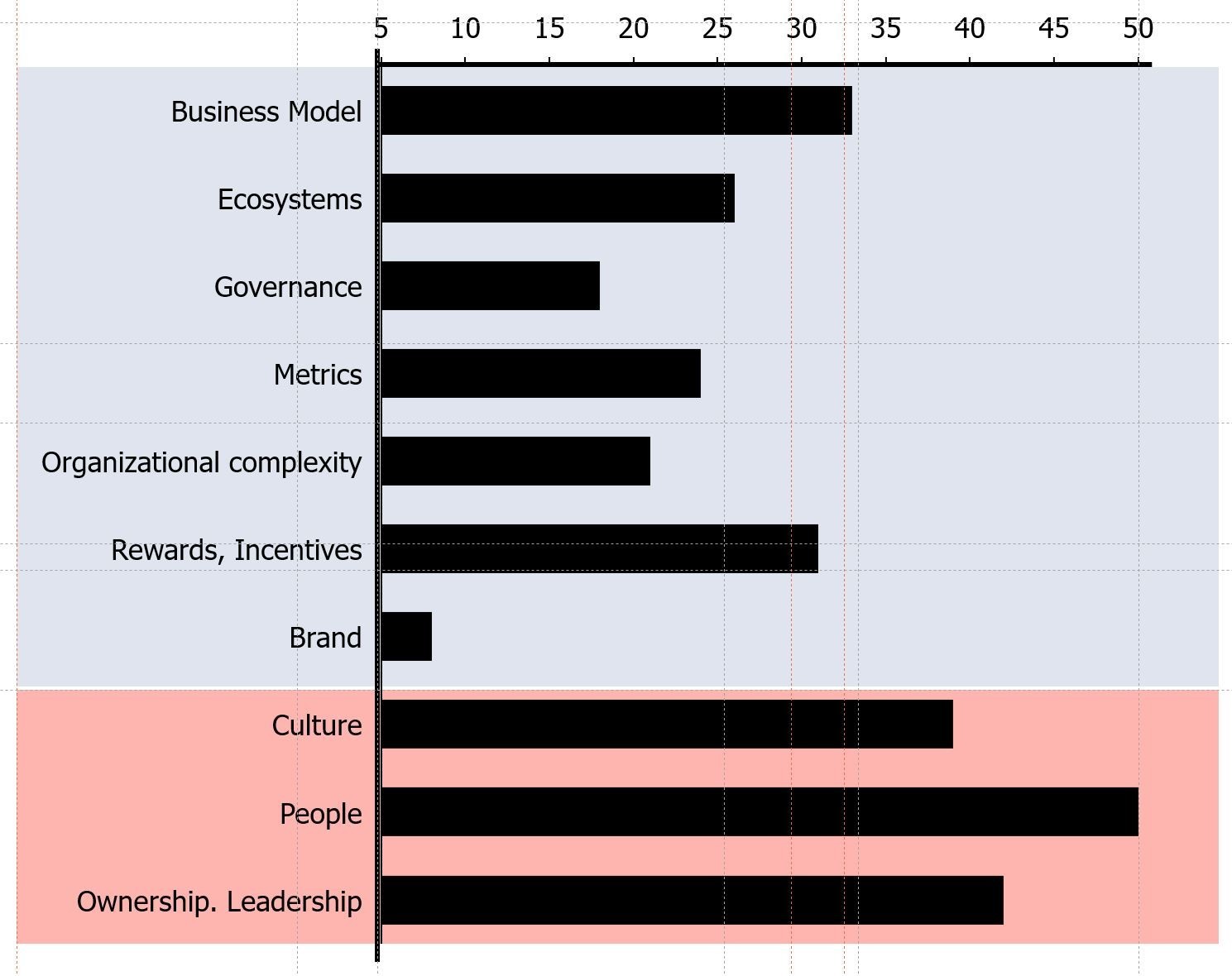Internal startups and corporate intrapreneurs are facing difficulties to scale, just like usual startups struggle at transforming their first customers in large business.
At the opposite of ‘start-up’ and ‘growth’ phases where methodologies blossom (as shown below), there is a lack of framework to support this stage: it’s the Death Valley for scaling-up innovation! Scaling Lean by Ash Maurya provides some interestings advices, and metrics for start-up scale up, but it does not address corporate scale-up specificities. Thus, corporate scale-up have simultaneously to win a market, and to convince internally the corporation.

Building on this analysis, my reowned peer for innnovation blogging, and experienced consultant at Innovation 3, Ralph-Christian Ohr has set-up a peer-group of companies, widely recognized as innovative, to tackle the ‘corporate scale-up’ issue, and professionalize scaling-up. I’m very happy to join the group for the next sessions. Ralph-Christian tells us more about it.
Ralph-Christian Ohr (co-written with Frank Mattes): As you may have noticed (see e.g. here) we have assembled a Peer Group of more than 10 premier European companies across various industries. Together with BP, Bosch, Continental, Evonik, Philips, Swisscom, Telefonica, SIX, TÜV Rheinland (and other companies that asked not to be named) we co-created a systematic approach to scaling up validated radical / disruptive innovation concepts to business impact. Below, we would like to share some of the results.
This article uses the language and terminology developed in our Dual Innovation thinking model, in particular the ‘Three Playing Fields’ framework. For more details, specifically the difference to the ‘Three Horizon’ model see here.
Scaling-Up: Internal or external path to value
Most companies struggle in the Scaling-Up phase, i.e. while transitioning a corporate startup into substantial results (see here). Consequently, those companies not only see disappointing return on their investments into exploring radical / disruptive innovation and building new business opportunities. They also have trouble in translating their Digital activities into large-scale transformation or significantly adapting their existing business / operating models.
In general, Scaling-Up can take two paths: Internal or external. For two reasons, the Peer Group decided to focus on the first one:
- The internal case covers the majority of scale-up ventures across all companies involved.
- Research provides a compelling case: Large companies that leverage the strengths of their core business have on average a 1-in-8 chance of creating a viable, large-scale new business. Chances of success for corporate ventures are roughly 1700 times better compared to ‘external’ start-ups if those ventures can benefit from a strong existing business and its scale advantages.
Scaling-Up addresses two critical issues: WHEN and HOW
When a company wants to turn validated radical / disruptive innovation concepts into business impact, two decisive issues must be addressed: WHEN and HOW to scale up.
Issue 1: WHEN to scale up
Knowing when a radical / disruptive innovation concept is ‘ready to scale’ proves to be the first building block to improve business impact.
Scaling up too early might lead to a bumpy road when important issues in the concept or its business model have not been detailed enough. Pivoting the business model during Scaling-Up phase is not an option since it will inevitably mess up the whole organization involved.
On the other side, scaling up too late might also lead to problems. If it takes too long to resolve all open issues and barriers, the intended innovation may not be in line with strategy anymore, misses the right point in time for market traction or gets outpaced by a disruptive competitor.
Interestingly, neither Design Thinking nor Lean Start-Up approaches provide a comprehensive answer to determine the optimal timing for Scaling-Up. We did some research and could not find substantial results either.
Lean Startup offers only a minor portion of the set of criteria that make up the basis for decision. Analyzing real-life cases from the Peer Group and the underlying patterns, we found that leading companies apply additional decision criteria. While the set of criteria does not provide a one-size-fits-all solution, the Peer Group felt confident that having these criteria on a scorecard would substantially improve Scaling-Up decision making.
Issue 2: HOW to scale up
The diverse background of our Peer Group allowed a very broad and general discussion about how to scale up. Very practically, the ‘HOW’ involves addressing four major challenges:
- Industrializing the product / service / business model
- ‘Crossing the chasm‘: Develop Pioneer customers and win Early Majority
- Growing the scale-up venture organization
- Transitioning the ‘Venture Management System’ to a ‘Business Management System’, addressing the ‘Areas of Tension‘ between those
‘HOW’ involves formal and collaboration aspects
We found that there are two dimensions that make up the ‘How’ in Scaling-Up: Formal aspects, and a more informal collaboration model.
Formal aspects
Formal aspects encompass critical components such as governance, budgeting / funding or KPIs / metrics. In the view of the Peer Group, the most practical model is to map those formal aspects onto an appropriate milestone structure that sections the overall Scaling-Up transition. However, this set of milestones is highly individual for each company / industry, depending on the nature of the innovation concept :
- B2C
- B2B
- B2B, OEM-targeted
- Digital
- Heavy-asset-investment
- Innovations that require regulatory approval
Collaboration model
Our work showed that ‘soft factors‘ are decisive for the scaling-up success. We see the formal aspects to be necessary but not sufficient conditions for scaling-up success.
If soft factors are so relevant for Scaling-Up success, there needs to be a model for collaboration between the scale-up venture and the core organization in place. A well-defined collaboration model ensures strengthening the day-to-day working relationship between ‘Scaling-Up stakeholder’ with different alignments and priorities in between formal decisions.
We found that this is not only suggested by research but there are some more reasons for doing so – one important being that this collaboration model makes the Scaling-Up phase tangible for Senior Leadership (see the relevance of the Leadership aspect here).
Join the Peer Group 2018
The Peer Group 2017 has proven to be a big success. All participants appreciated the outcome generated and expressed their intent to carry on into 2018.
We will be opening up the setup to onboard a few more suitable companies in the next weeks. So if you are a corporate practitioner, and want to join this group or if you seek to have more insight into the topics and our findings, please leave a comment or drop me a direct message (via Linkedin).




12 Comments